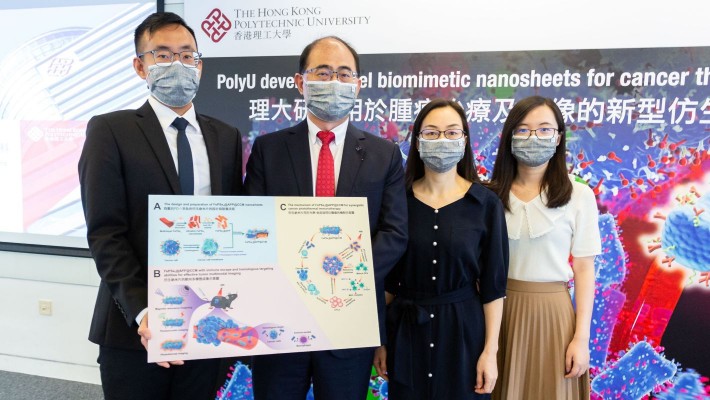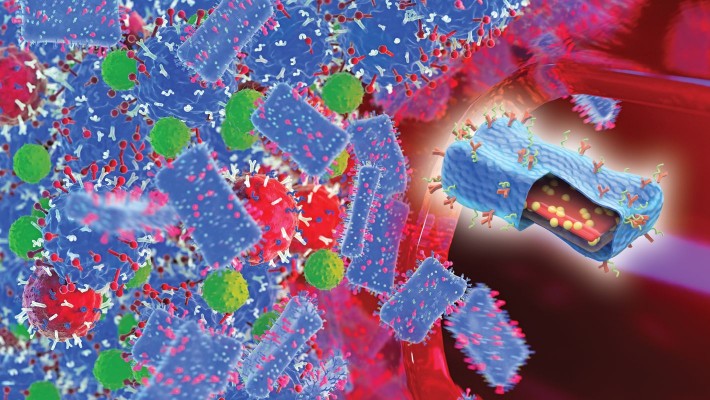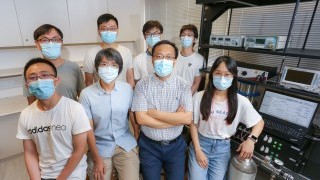Biomimetic nanosheet enables synergistic therapy and multi-modal imaging to fight cancer
Other Articles
PolyU researchers mimic biochemical processes to develop a novel type of nanosheet for the treatment of tumours
A research team from PolyU’s Department of Applied Biology and Chemical Technology, led by Professor Wing-tak Wong, Deputy President and Provost and Chair Professor of Chemical Technology, has developed a novel type of biomimetic nanosheet. The innovation integrates two emerging cancer therapies (immunotherapy and photothermal therapy) with three imaging modalities (magnetic resonance imaging (MRI), photoacoustic imaging (PAI) and photothermal imaging (PTI)) for the first time.
The novel two-dimensional nanosheet, made with iron phosphorus triselenide (FePSe3), enables doctors to choose the best imaging modality and treatment for patients. It also facilitates the development a new generation of cancer theranostic (the combination of diagnosis and therapy) agents which are safe and have a high targeting ability and efficacy. The novel biomimetic nanosheet can significantly improve the therapeutic outcome, reduce side effects and increase patients’ survival rates.
The team’s findings have been published in the prestigious international journal Advanced Science.
Synergistic therapy – Combining immunotherapy and photothermal therapy
When cancer cells develop in the body, the immune system releases a type of white blood cell called T cells to attack the tumour cells. Cancer cells fight back by releasing a protein called PD-L1 (Programmed cell death–ligand 1) which inactivates the immune system by binding to the T cell’s PD-1 (Programmed cell death 1).
The researchers loaded the nanosheet with a drug called anti-PD-1 peptide (APP) inhibitors. When the biomimetic nanosheet is injected into a patient’s blood stream, it finds its way to the cancer cells, where the drug is released to block the binding between PD-1 and PD-L1, reactivating the T cell's immunity function.
The large surface area of the nanomaterials enables the drug loading ratio of APP to be optimised. As a result, the drug dosage can be reduced, lessening side effects and enhancing the therapeutic efficiency.
The nanosheet can also facilitate photothermal therapy, as FePSe3 can efficiently convert near infrared (NIR) laser irradiation into heat to kill tumour cells. The heat further promotes immunotherapy and, in doing so, effectively inhibits tumour growth.
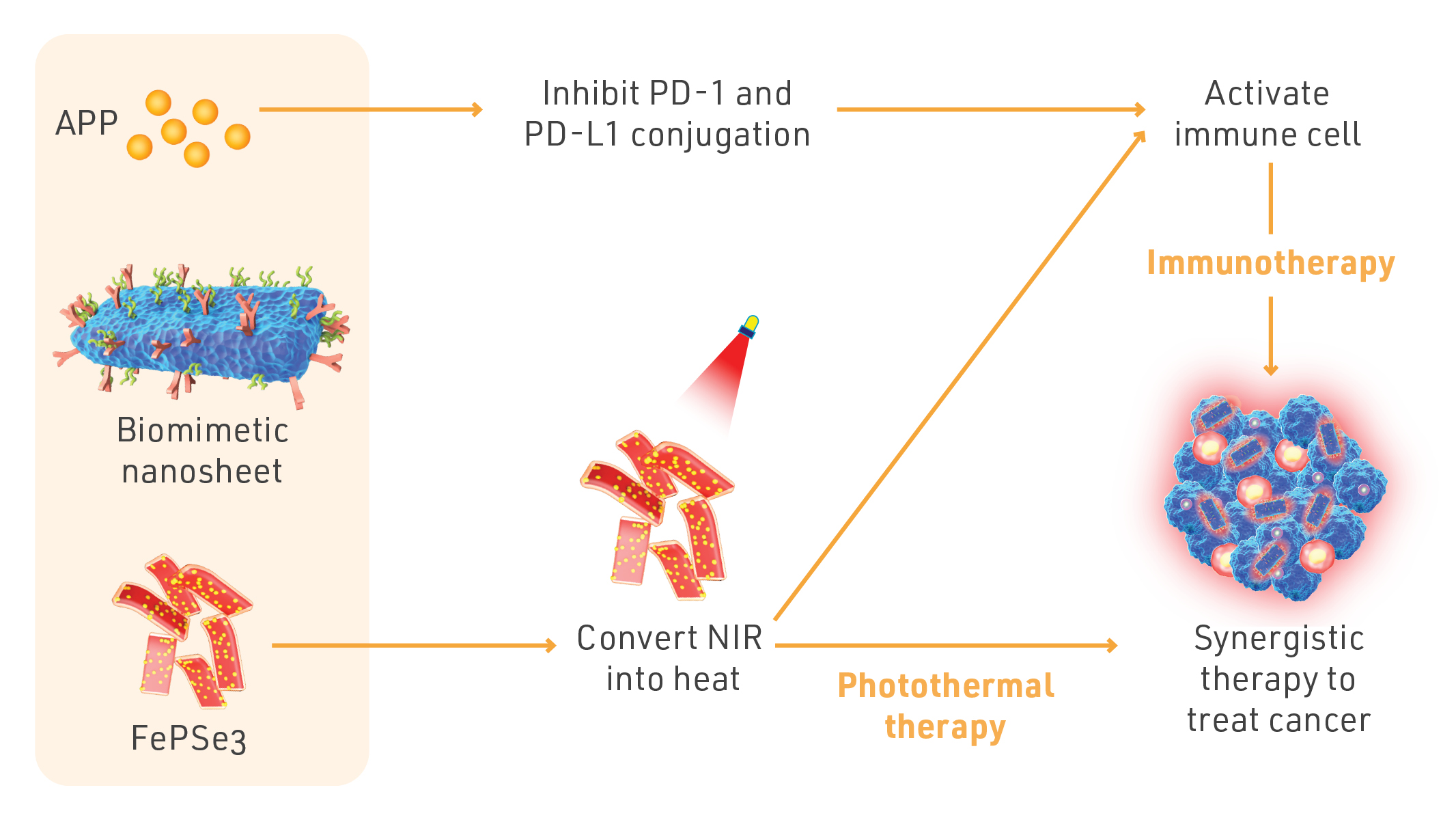
The synergistic therapy of biomimetic nanosheets
| Delivering the drug to hit the cancer cells As the innate immune system attacks foreign objects, the researchers disguised the nanosheets by coating them with cancer cell membranes. Cancer cells tend to adhere to each other, so using a cancer cell membrane disguise will enhance the nanosheet’s targeting property. As soon as the nanosheet attaches to a tumour, the cancer cell membrane will adhere to the cancer cells, peeling away from the nanosheet, revealing the nanomaterials and releasing the inhibitors for immunotherapy. |
Treatment, diagnosis and real-time monitoring all-in-one
As well as enabling synergistic therapy, the nanosheet can also facilitate effective diagnosis, as FePSe3 possesses magnetic, optical and thermal properties that allow MRI, PAI and PTI multi-modal imaging. These properties make it an ideal basis for developing a theranostic agent.
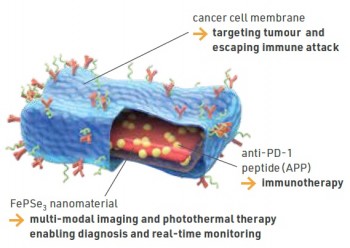
The nanosheet is designed to perform multiple functions.
This multi-modal imaging also enables real-time monitoring of tumour development and treatment, such as viewing the localisation progress with MRI, tracking tumour growth with MRI/PAI and monitoring the increase in temperature with PTI. The variety of treatment and imaging options available, allows physicians to choose the ones which best for each patient.
As a result, the nanosheet has the potential to become an “all-in-one” theranostic nanoplatform for multimodal diagnosis and synergistic therapy.
Promising application prospects
Professor Wong started the research with his team in 2018. He said: “Over the years, our biology and chemical experts have been dedicated to new drug development and have achieved some significant breakthroughs, especially in cancer treatment. The newly developed biomimetic nanosheet is part of PolyU’s endeavours to fight cancer.”
The PolyU team will expand the application of the nanomaterial to other cancer therapies, study its therapeutic effect under prolonged treatment and investigate the metabolism of the nanosheet in the living body, to enable more cancer patients to benefit from new theranostic methods.



